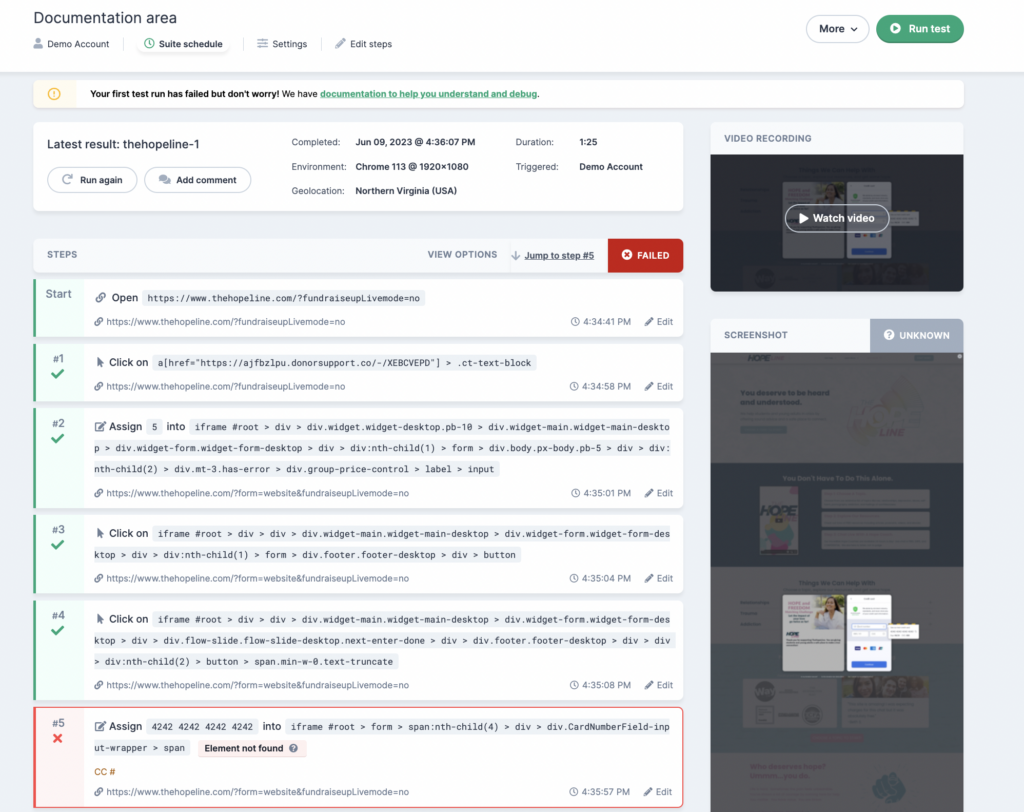Because retesting and regression testing have many similarities, it’s easy to get them mixed up. Both are software testing methods used to maintain the usability of a website or web app, and both involve testing your software repeatedly. Thankfully, there are some key differences between the two that are easy to remember when learning how to distinguish one from the other. Read on for a simple breakdown of retesting vs regression testing, so you never end up confusing them again.
Table of Contents
What is regression testing?
Regression testing is a type of software testing done to confirm that new code or feature updates to your website or web app won’t cause new problems, or regressions. This test technique ensures that previously-tested features won’t break down after you’ve implemented a change.
The steps of a regression test are as follows:
- Determine which test cases to run
- Set up the test environment
- Execute tests to ensure that software is running properly without regressions
- Document and report any identified defects, regressions, or unexpected behavior from test results
- Work with developers to troubleshoot solutions for any regressions
- Retest failed test cases
- Evaluate overall results for further testing
With regression testing, QA teams can oversee the usability and reliability of their applications by continuously monitoring features and functionalities after modifications are made. Overall, regression testing bolsters confidence in the integrity of a software and helps developers and QA teams to prevent the recurrence of code issues.
What is retesting?
Retesting is a kind of software testing done after a problem has been detected and an attempt has been made to fix a feature or functionality. It’s typically one of the steps included in the regression testing process. The purpose of retesting is for developers to ensure that functionality has been restored to a specific failed test case, so retesting is only implemented after a problem has been found.
The steps for retesting a test case are:
- Identify defect
- Prepare test environment to replicate the scenario where the defect occurred
- Run the retest
- Evaluate test outcomes
- Document results and report on whether there were any additional problems that occurred after the retest
Remember, retesting is only done after a test failure has already occurred, in contrast with regression testing, which should be executed as a form of quality assurance regulation.

Create automated regression tests with Ghost Inspector
Our 14 day free trial gives you and your team full access. Create tests in minutes. No credit card required.
Retesting vs Regression Testing Cheat Sheet
Check out the table below for a speedy guide to some key differences between regression testing and retesting.
| REGRESSION TESTING | RETESTING |
| Considered “generic testing” | Considered “planned testing” |
| Testing for working software to determine if there are any unknown issues | Testing for software that wasn’t working to confirm that now it will |
| Run for passed test cases | Run for failed test cases only |
| Can be automated | Cannot be automated |
| Does not test defect fixes | Does test defect fixes |
| Ensures that no issues crop up from a code or feature update/change | Ensures specific problem is corrected |
| Does not include defect verification | Does include defect verification |

Retest or Regression Test: Test Case Scenarios
For those who learn better by example, here are two scenarios that might present themselves in a typical software development environment. See if you can guess whether the scenario requires retesting or regression testing before you get to the answer at the bottom of each paragraph.
Scenario 1 – Add to Cart Bug
Summary: Several users have reported that they are unable to add a product to their shopping carts on your eCommerce website. Your QA team found the bug, spent time troubleshooting the issue, and deployed a fix. You are now called in to run a test to ensure the functionality of the Add to Shopping Cart button. You do so on multiple browsers and devices to ensure that the button is now working correctly. Is this retesting or regression testing?
Answer:
This is retesting. You are fixing a specific problem from a failed test case.
Scenario 2 – New Login Functionality
Summary: Your company has updated their web application with new login security measures to ensure safety after a potential breach. You are called in to test the login process and ensure that the existing functionality is still intact after the update. You run the test and find everything to be in working order across multiple browsers and devices. Is this retesting or regression testing?
Answer:
This is regression testing. An update has been introduced and now you must confirm that it has not caused any regressions in the login process.
Were you able to identify both types of testing correctly? Although you might need to remind yourself of some of the details, the differences between retesting and regression testing are fairly simple to understand.
Managing Test Cases with Ghost Inspector
Ghost Inspector helps developers and QA teams manage both retesting and regression testing more efficiently. Here’s how Ghost Inspector can be implemented for both testing scenarios:
Regression Testing: Ghost Inspector can be used to simplify regression testing by allowing testers to design automated test scripts to simulate user interactions with a website or web app. These tests can be saved and run repeatedly with automation to help prevent any regression bugs from causing problems.
Retesting: Although the retesting process cannot be automated, Ghost Inspector assists with the retesting process by giving testers the ability to record and save test cases that cover the specific features or areas of an application that need to be retested. These tests can be replayed as needed, saving tester teams time spent on manual test processes and ensuring that previously fixed issues remain resolved.
Ghost Inspector offers numerous features that support regression testing and retesting, including:
- Test Recording
With Ghost Inspector, you can easily record your interactions as user flows within your website or web application. The test recorder allows you to save these flows as test cases that you can replay later during retesting or regression testing. Plus, you can easily make updates to these tests with our codeless test editor.
- Test Scheduling
Ghost Inspector allows you to schedule regression tests to run automatically on specific days, times, or intervals, so you can test continuously and keep tabs on the functionality of your application at all times.
- Results Tracking
Ghost Inspector records and stores the test results from every test run, including screenshots and detailed logs. This feature helps software tester teams to quickly find and troubleshoot problems that come up during retest and regression test cases. - Integrations
Ghost Inspector integrates with numerous build and deployment and project management tools, including Github, Azure DevOPS, Jira, and Slack. Not only do these integrations allow testing teams to easily track and address problems that come up during retest and regression tests, but they also help streamline the testing process further, making it easy to automate regression testing as much as possible.
Conclusion
Both regression testing and retesting are essential parts of the developer testing arsenal. A proper understanding of the difference between these two types of testing is essential for every budding software tester. Now that you have a stronger comprehension of retesting vs regression testing, you’re ready to move on to the next challenge. And for those interested in streamlining their operations when it comes to both retesting and regression testing, Ghost Inspector is an ideal addition to your team testing tools. Because it offers features for both novice and expert testers, Ghost Inspector democratizes the testing process, making it easy for your entire team to run high-quality tests, even those with no coding experience.
If you’re interested in learning more about Ghost Inspector, you can sign up for a free trial or head here to schedule a free demo with a member of our team.
Create automated regression tests with
Ghost Inspector
Our 14 day free trial gives you and your team full access. Create tests in minutes. No credit card required.


